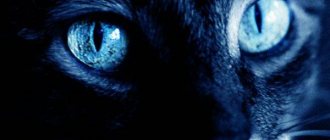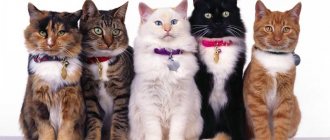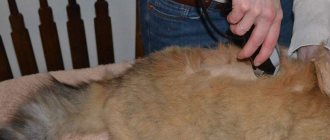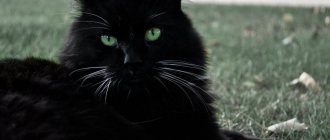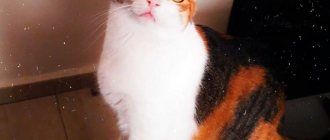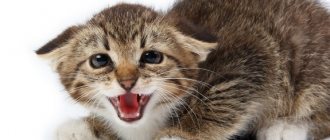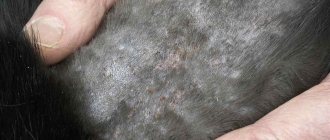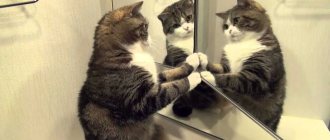In the material we covered the topic of cat vision, its characteristics, the ability of cats to distinguish colors and see the world around them. There are many myths and fairy tales surrounding these animals, but what is true? How does your pet really see the world? In this article you will learn the answers to these questions, and also understand how to recognize your pet’s vision problems and how to help your pet if the symptoms are confirmed.
Connection with the other world
There are many myths and legends around cats. The ancient Egyptians worshiped these beautiful creatures and believed that they had a clear connection with the other world, namely they could see spirits and the afterlife. Of course, from confirmation, we only have incredible stories of lovers of these animals, or, from close ones, the story of a neighbor, Aunt Lucy, who claims that her cat hisses into the void, and precisely at the moment when inexplicable rustlings are heard in the corridor.
In general, there is a rational explanation for this behavior; cats can really see what we humans cannot. In 2014, studies were conducted that showed that their eyes have ultraviolet vision, which confirms that they actually notice things that our human vision is not given.
In fact, our pets initially see the world differently, and this is due to many factors, from the structure of the eye to color rendition. What kind of vision do cats have?
What are the characteristics of a cat's vision?
Let's start with the structural features. The very first difference is the large size of the eyes, and if you look at their scale relative to the size of the body and head, then the Cat's eyes are simply huge. Cats are the only domestic animals with such eyeballs. Associated with this feature is another important one – viewing angle. In cats it is up to 270°, while in humans it is only 180°.
Cats' eyes are set deeper in the skull than humans, so they are better protected. Also, for additional protection, cats have a third eyelid, which is closely adjacent to the membrane of the eye in its inner corner; it also helps the movement of tear fluid through the eye. This eyelid can be seen when a cat is dozing with her eyes slightly open. We also note the peculiarity of the location of the eyes: they are directed forward (unlike their victims) and are located close to each other.
Cat's eye in profile.
The picture that the cat perceives with its right and left eyes are combined and this allows it to form a general, three-dimensional image. Cats have binocular vision, meaning they see everything in 3D, just like humans. Thanks to this, cats are able to accurately determine the shape, size of an object, location and distance to it, which is especially important during hunting.
The significant superiority of cats over humans is visual acuity, which is almost 3 times higher than that of humans. Cats perceive up to 50 frames per second, while we perceive only 24 frames, so cats are better able to distinguish objects that are in motion, especially in the horizontal direction, but it is much more difficult for cats to recognize movement in the vertical direction. This feature is due more to evolution; mainly the prey that felines hunt move along a plane.
On a bright sunny day, cats' pupils are usually constricted into thin vertical lines to reduce stress on the sensitive retina by reducing light output. Seeing perfectly in the evening, cats see much worse during the day, which is why many of the Murziks and Muroks prefer a daytime siesta and evening promenades (i.e., sleeping off during the day in order to stay awake at night).
Cat pupils in bright light.
Cats and "evil spirits"
We have found out what traditional science says about how cats see our world. But behind the veil of secrecy there remains something else, even more exciting and interesting - whether, according to ancient legends, traditions and modern posts on forums, cats can see the otherworldly and even fight with it.
The cat is an excellent guardian of the home from evil forces.
Both ancient tomes and modern web resources are full of chilling stories about how a small cat “with all the strength of her aura” fought for the happiness and health of her owners against something black and terrible. There are also others, funny ones, about how a young cat and a house-elf “had a blast” all day and night long.
To believe or not to believe in such half-fairy tales depends on whether there is any faith in the mystical in the soul of each individual reader. But the fact that the cat’s aura is so huge that it covers both the animal and the owners, and the entire territory that the cat considers its home, and is so strong that it is capable of releasing negative vibrations beyond the territory that the cat has designated as its own, is confirmed by esotericists of all levels.
https://www.youtube.com/watch?v=kUJBKi_ODGU
Also, the animal is able to subtly sense the emotional state of a person, so flirting with a cat and deceiving it is useless.
If the cat stares into emptiness, its pupils are dilated and it behaves calmly, the owners should not sound the alarm either. There is no talk of any evil spirits, it’s just that both the cat’s vision and hearing are much more developed, so she sees and hears things that are quite ordinary for her, but inaccessible to humans - not from somewhere from outer space, but perhaps from... under the baseboards.
The cat is a magical animal
If a cat follows the walls, ceiling, and pieces of furniture with its eyes, it may have noticed a brownie who visited the room with an audit and is busily walking around the perimeter. But this option is most likely from the category of old wives' tales.
Cats, unlike other domestic animals, feel calm and even comfortable in unfavorable energy zones of the house; they are able to transform negative energy.
Cat in the fight against astral guests
Esotericists describe the contact between a domestic cat and an astral entity as follows: having noticed a foreign otherworldly body on its territory, the cat freezes for a while and watches it - determines its intentions. And if the animal thinks that the alien from the astral plane is too dangerous for its owners, it begins to displace the essence with its energy.
If the entity is too strong or too stubborn, the cat “pulls” it into itself and leaves the house - diverting the danger from its territory. Often brave little fighters do not return home after such a “journey”.
A cat is able to concentrate positive cosmic energy over the house and bring prosperity, wealth, and well-being into the life of its owners.
It seems that the world through the eyes of cats, as they see it, is even more populated and dangerous than we could ever imagine.
And the most pleasant thing that is attributed to cats is their ability to concentrate positive cosmic energy over the house (their territory) and bring prosperity, wealth, and well-being to the lives of their owners. But here, as they say, rely on the cat, but don’t make a mistake yourself. Not everyone inherits puss in boots, and all the feline energy efforts are unlikely to help a hopelessly lazy person. But if you back up your own achievements with the energy of a cat of the right color, then anything can happen.
How far can they see?
Cats are farsighted creatures. They can examine in detail an object that is located at a sufficient distance from them (from 0.75 meters to 6 meters), the maximum distance is 60 meters, but cats see everything that is nearby blurry.
“Cats don't have the muscles needed to change the shape of their eye lenses, so they can't see as clearly as close as humans and need to move away from objects,” says Ketring. “And although your pet may be excellent at catching mice scurrying in fear, many slow-moving objects visible to the human eye appear motionless to cats.” To explore objects that are too close, the cat resorts to other senses, which are also well developed - smell and touch.
A good example: how a person sees, and how a cat sees the same picture.
What colors do cats see?
For a long time it was believed that purrs had monochrome vision (a congenital disease characterized by complete color blindness), but in the last century scientists finally proved that this is not so; cats have color vision. Of course, a cat’s color perception is much worse than a person’s, but still the world plays with different colors for it.
The color range they distinguish is: black, white, blue, green, yellow, and gray occupies a very important place. Murks can distinguish up to 26 of its shades (this is also due to evolution, since almost all animals that felines hunt are gray in color colors).
Auxiliary organs
In addition to the eyeball, the cat’s visual system also includes auxiliary organs that provide its protection. These bodies include:
- Upper eyelid.
- Lower eyelid.
- Third eyelid.
Anatomy of a cat's eye
Since cats do not have eyelashes in the traditional sense, they need organs that provide protection to the eye shell from environmental particles - dust and microbes. These tasks are performed by all three eyelids, which, in addition to protecting the eye, are responsible for its nutrition and distribution of lubricating fluids throughout the cornea to prevent drying out.
Third eyelid
The third eyelid (nictitating membrane) performs several important functions, which should be discussed in more detail. In a healthy state, the third eyelid is invisible to the naked eye. It can be detected only in those rare moments when the fold of the conjunctiva straightens and covers a large surface of the eye - for example, when the cat's head is tilted at a certain angle.
If you can discern a third eyelid on your pet's eye, it's time to take him to the vet.
Also, the third eyelid becomes noticeable when it is inflamed or due to other pathological processes in the cat’s body. A visible third eyelid is a good reason to immediately consult a veterinarian.
The functions of the nictitating membrane include:
- production and distribution of tear fluid throughout the eye membrane;
- retention of the tear film on the cornea;
- protection of the cornea from mechanical damage and injury;
- immunological protection against microbes.
The third eyelid is present not only in cats and other mammals, but also in humans
It should be clarified that the exact functions of the third century remain largely unexplored to this day. In determining the significance of the nictitating membrane, zoologists move from the opposite direction, determining what damage damage to the third eyelid brings to the eye.
The person preserved the “remains” of the third eyelid in the inner corner of the eyes
Both cats and humans have a third eyelid. The difference in the structure of the human eye is that the third eyelid plays the role of a vestigial organ, which has turned into a small bulge in the inner corner of the eye. The reason for this change in the third eyelid lies in the fact that a person does not grab prey with his teeth and does not eat from the ground, which reduces the likelihood of contamination of the eye and eliminates the need for additional protection of the eye shell.
The functions of the third century have long been of interest to scientists, but the purpose of this organ remains a mystery.
Rudiment or useful device?
At the beginning of the twentieth century, the nictitating membrane was treated as a completely unnecessary organ. Moreover, the practice of removing the third eyelid was widespread, which supposedly simplified the life of a pet, ridding it of this “relic of the past.” Such careless actions led to an imbalance in the eye: the visual system lost the ability to produce a sufficient amount of tear fluid, which led to dry eye syndrome. The third eyelid was partly regulated with the help of the nervous system, and therefore its removal did not pass without a trace for her.
A hundred years ago, cats underwent surgery to remove the third eyelid, which caused harm to the animal.
Today, scientists are inclined to believe that the third eyelid is not an exception, but rather the norm among mammals and birds. Its absence (or rather, modification) in primates and humans is an interesting curiosity, and not a rule that should apply to all other species.
What colors does a cat not distinguish at all?
But cat’s eyes are not able to perceive this range of colors: red, brown, multi-colored combinations. Since the brightness of the images is greatly reduced, a cat may often confuse white with yellow, or almost black with orange or red.
If you have a question, why then do cats run after the red dot from the laser? In fact, the color scheme does not matter to cats; their attention is attracted precisely by the fact that the point is in motion.
How do cats see in the dark?
Animals see due to the fact that light, passing into the eye, irritates the nerve endings of the retina, then these irritations are transmitted along the fibers of the optic nerve to the brain and appear in the head in the form of a “picture” that we see. This information mainly refutes the myth that cats can see perfectly in pitch darkness.
Our favorites are more crepuscular animals, their vision is tuned to perceive dimly lit space (this is especially important for hunting). With very poor lighting, a cat receives significantly more visual information compared to a human. A cat can distinguish objects and other animals in light less than 20% of the amount of light required by the human eye.
Here you can also pay attention to the retina of the eye, covered at the back with tapeum; it works like a mirror - it reflects the light that hits it onto the photoreceptors. As a result, the cat's eyes begin to glow. All nocturnal predators have this substance. Thanks to this feature, our pets see better in the dark.
The most important myth is that cats see in complete darkness.
Some more interesting facts
In order to find out how cats see the world around them, scientists conducted an experiment. Electrodes were implanted into the cat's brain and connected to 177 neurons. When the data from the electrodes was received, they were displayed on a computer and people saw the world through the eyes of a “murka”. It turns out that the general plans in front of the cat appear very vague, but she sees the faces of people, the outlines of other animals, as well as the slightest movement very clearly. This is clearly shown in the photograph.
Now look at the next photo. It shows two pictures: the top one is the visible “picture of the world” by a person, the bottom one is, respectively, by a cat
Pay attention to the ends of the photo. On the top side you see black stripes
This is where human peripheral vision ends (approximately 180°), blurring at the edges shows that the available image coverage of a person at the edges is deteriorating. And the bottom photo shows the peripheral vision of cats - more than 200°.
But cats can follow fast-moving objects without losing sight of, for example, a flickering sunbeam. A person does not have time to follow the rapid flashing
However, people are 10 times better able to see slowly moving objects, and a cat is not able to systematically maintain attention on one object without being distracted by others
We hope that after reading the article, you learned a little more about everyone’s favorites - cute cats, these capricious, incomprehensible and very complex creatures.
To summarize the story, let us recall the main facts:
- In pitch darkness, purrs cannot see anything, just like humans.
- They contemplate the beauty of the world in faded shades of the cold color spectrum.
- They only clearly see faces and moving objects.
- Their area of peripheral vision is wider than ours.
- They cannot see beyond their noses beyond 6 meters.
- They can see more shades of gray.
- They see perfectly in dense twilight, if there is at least a little scattered light.
True, pets need their wonderful adaptation - night vision - mainly to find a bowl of food in the dark in the kitchen. If you have a furry friend at home, watch him, because the eyes of your beloved creature can tell a lot.
How does a cat see a person?
If we pay attention to all the facts that we have listed, we will understand that our pet sees us almost as we are, except that the colors are slightly different and the figure is more blurred. And if we are in close proximity to them, then the animal will definitely not distinguish facial features. Since most often we are at a minimum distance from our pet, it is unlikely that he knows what kind of nose or lips you have, it doesn’t matter to him at all. The smell of a beloved owner is much more important; his animals will definitely not confuse him with anyone else.
Do they see the image on TV and their reflection in the mirror?
Scientists have different opinions on this question; some argue that cats only see flickering, because... vision in good light is inferior to night vision. Others note that cats can purposefully look at the TV screen and observe what is happening. However, if the Murks see what is happening on the screen, then for them it is more of an alternating change of pictures, like a slide show (I remind you about the perception of 50 frames per second).
But they perceive their reflection in the mirror well, it’s just that this picture does not arouse much interest in them, since they cannot perceive it with other senses, that is, they cannot smell it.
Cat eye shape
Most representatives of the cat world have oval-shaped eyes. Almond-shaped eyes are characteristic of individuals of the eastern type, in particular Siamese. Their eyes are set at a slight angle. Round eyes are characteristic of the Persian, an exotic shorthaired breed.
Meowing pets are nocturnal animals by nature, although they are also active during daylight hours. Their pupils are vertical, because thanks to this shape, the pupils can quickly change size, unlike a round pupil, and adapt to different lighting conditions. The narrower the pupil, the less light passes through it, and if the level of illumination suddenly changes, the animal does not risk being blinded.
Large eyes allow the animal to see well ahead and below, and successfully track prey.
Vision problems
The eyes of a cat are not only the dignity and decoration of this beautiful animal, but also one of the weakest points. Very often, pets develop diseases that put the clarity and health of their vision at risk. Some of the most common eye diseases that occur in cats include conjunctivitis, cataracts, glaucoma, keratitis, sequestration (necrosis) and epiphora. Any alarming symptoms (for example: lacrimation, squinting of one or both eyes, redness, discharge of pus, photophobia, change in the color of the iris, etc.) is a reason to consult a doctor, preferably a specialist - a veterinary ophthalmologist.
Watery eyes and other problems
It is important to know that diseases that affect the eyes of cats can be not only ocular, but also systemic. A number of infectious diseases occur with purulent discharge from the eyes.
Let's look at the main causes and diseases that lead to excessive tearing:
- Conjunctivitis. It is an inflammation of the inner mucous membrane of the eye and is accompanied, in addition to lacrimation, by redness and swelling. The animal often rubs its eyes, blinks and squints. After sleep, the eyelids stick together. In most cases, conjunctivitis can be a manifestation of some serious disease.
- Activity of parasites. Neglecting anthelmintic treatment can lead to your pet becoming infected with worms. In this case, there is usually swelling of only one eye and profuse lacrimation.
- Keratitis. If the eyes are covered with a cloudy film, redness and discharge are observed, then most likely the cornea is inflamed. Trauma or infection can lead to the development of this disease.
- Blepharitis. The primary symptoms of the disease include inflammation of the eyelids, itching and redness. In the absence of therapy, profuse lacrimation begins, crusts and swellings form. This pathology is often confused with conjunctivitis; a specialist can make the correct diagnosis.
- Allergy. In addition to lacrimation, reactions to external irritants can include itching, rash, sneezing, shortness of breath and even vomiting.
- Infectious diseases. Chlamydia or calcivirus can cause lacrimation. The first disease is also accompanied by fever, nasal discharge, and cough. Calcivirosis is characterized by fever, lethargy, lack of appetite, inflammation of the gums, and sometimes lameness develops.
- Respiratory diseases. Watery eyes may be a consequence of a cold. In this case, it is accompanied by sneezing, coughing and fever.
- Injuries and foreign objects. Street travel and fights can cause damage to a cat's eyes or a foreign object getting into them. In addition to copious tears, injury is accompanied by swelling, redness, and clouding of the eye. If the injury is serious, the animal meows in pain and constantly rubs the problem area. In addition to tears, pus or blood may flow from the animal's eyes.
- Congenital structural anomalies. The incorrect structure of the eyelid, when it either turns strongly inward and irritates the conjunctiva, or, conversely, turns outward, opening access to dirt and external irritants, leads to lacrimation.
- Glaucoma. When intraocular pressure increases, in addition to discharge, redness and clouding of the lens are observed.
- Cataract. This is a fairly rare disease in cats. Its development is typical for older animals. Cataracts are incurable, but if detected at an early stage, it is possible to significantly slow down the clouding process.
An example of conjunctivitis in an animal.
How to notice the symptoms?
If there are changes in your pet's behavior:
- rubs eyes with paw ·
- blinks frequently
- avoids bright light
- squints
Symptoms in eye condition: ·
- accumulation of pus in the corners of the eyes
- lacrimation ·
- swelling of the eyelids
- redness ·
- cloudiness of the eyeball
To detect these symptoms, be more attentive to your pet and periodically conduct self-examination. If, during the next examination of your cat's eyes, you notice alarming symptoms, then wipe your eyes with a damp cloth and observe how soon the discharge appears. If your fears are confirmed, then, of course, you need to see a doctor, no home self-medication, this can lead to even more complex consequences!
Healthy eyes, in normal lighting.
What to do if your cat begins to see poorly?
If you notice that your cat has begun to navigate space differently, then pay attention to the following points in its behavior: The cat refuses to jump or does it awkwardly. The cat comes across objects that are in a new place for it. The cat looks past you. The cat's pupils are statically dilated. Do any of the points apply? Then remember that you should not let a cat with poor vision out of the house, it is also not advisable to rearrange the furniture and remove bowls of water and food from its usual place, because the cat knows where everything is and can perfectly navigate in space blindly, including others, well developed sense organs.
It has been proven that the longer a cat's whiskers, the worse her eyesight.
Do cats see the paranormal world?
The cat is considered a magical animal. Esotericists believe that thanks to her aura, she is the guardian of not only a person, but also his family. The animal not only guards the house from the penetration of otherworldly entities. If they have already settled in the house, the cat drives them out.
Remember the old custom: when moving to a new home, let the cat in first. It is believed that when evil spirits are detected in the house, the cat expels it using its biofield. If the animal fails to do this, then it takes the evil spirits with it, removing the threat from the apartment.
Psychics and all kinds of mediums believe that an animal is able to drive away a ghost or the soul of the deceased from the house, so it is impossible for a cat to be nearby during a spiritualistic session.
Egypt, Japan, Thailand, Burma - this is an incomplete list of countries where cats are revered and magical abilities are attributed to them. Many of us have seen how a domestic purr rests quietly with his eyes closed.
Find out which cat breed is the smartest, how a flea and tick collar works, how to deliver a cat, how to care for a cat after sterilization, what a cat purr means, how to get rid of dandruff in a cat and how to make toys for a cat with your own hands.
In fact, scientists explain this by the animal's visual characteristics. As already mentioned, the cat sees perfectly at a distance of up to seven meters, but the animal does not see very well directly in front of it.
But the vibrissae add a huge amount of information. Therefore, in case of a lack of visual image, the whiskers supplement the “information file” entering the animal’s brain.
The result of such a mixed presentation of information may be an animal’s reaction that is incomprehensible to us. Imagine that you are having an afternoon siesta, a light nap, a good mood, and then a clear visual image appears in your brain - your child is smoking during recess.
Moreover, you do not doubt the veracity of the information. Your reaction will probably be similar to a cat's sudden outburst of rage.
Did you know? The cat is unable to chew large pieces of food. The reason for this is the inability to move the jaw from side to side, only up and down.
